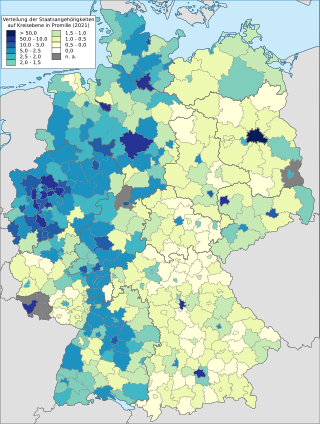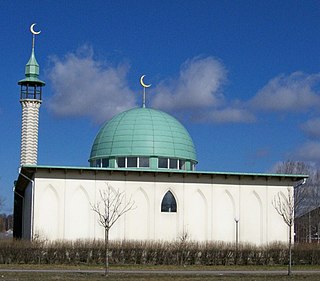
This is a demography of the population of Lebanon including population density, education level, health of the populace, economic status, religious affiliations and other aspects of the population.
Palestinian refugees are citizens of Mandatory Palestine, and their descendants, who fled or were expelled from their country over the course of the 1947–1949 Palestine war and the Six-Day War. Most Palestinian refugees live in or near 68 Palestinian refugee camps across Jordan, Lebanon, Syria, the West Bank and the Gaza Strip. In 2019 more than 5.6 million Palestinian refugees were registered with the United Nations.

Arab Americans are Americans of Arab ancestry. Arab Americans trace ancestry to any of the various waves of immigrants from the Arab world.

Arab diaspora is a term that refers to descendants of the Arab emigrants who, voluntarily or as forcibly, migrated from their native lands to non-Arab countries, primarily in the Americas, Europe, Southeast Asia, and West Africa.

The phenomenon of large-scale migration of Christians is the main reason why Christians' share of the population has been declining in many countries. Many Muslim countries have witnessed disproportionately high emigration rates among their Christian minorities for several generations. Today, most Middle Eastern people in the United States are Christians, and the majority of Arabs living outside the Arab World are Arab Christians.

Arab Canadians come from all of the countries of the Arab world. According to the 2021 Census, there were 690,000 Canadians, or 1.9%, who claimed Arab ancestry. According to the 2011 census there were 380,620 Canadians who claimed full or partial ancestry from an Arabic-speaking country. The large majority of the Canadians of Arab origin population live in either Ontario or Quebec.

Arab Brazilians are Brazilian citizens of Arab ethnic, cultural, linguistic heritage and identity. The majority of Arab Brazilians trace their origin to the Levantine region of the Arab World, known in Arabic as Bilad al-Sham, primarily from Lebanon and Syria, as well as Palestine. Arab Brazilians are Christians in the great majority. The first Syrians and Lebanese arrived in São Paulo around 1880. It is not known exactly when, although the Syrians and Lebanese say that in 1885 there was a small core of peddlers working in the market square. By 1920, the census listed 50,246 Syrians and Lebanese in Brazil, 38.4% (2/5) of these in the state of São Paulo. The 1940 census enumerated 48,614 Syrians, Lebanese and other related groups with a decrease of approximately 1647 people. As immigration almost ceased after 1929 and the colony aged, it is surprising that the decline was not even greater. The trend of the period between 1920 and 1940 was the continuous concentration of Syrians and Lebanese in São Paulo. Almost half (49.3%) of Syrians and Lebanese residents in Brazil lived in São Paulo.

British Arabs are British citizens of Arab descent. They share a common Arab ethnicity, culture, language and identity from different Arab countries. Arabs also come from non-Arab countries as ethnic minorities.
Arab Haitians are Haitian citizens of Arab descent. In Haiti, there are a sizable number of Haitians that are either of Middle-Eastern Arab ancestry or who trace their origins to Arab descendants. Hadrami and Levantine Arabic ancestry can be found within the Arab Haitian community known in Arabic as Bilad al-Sham, primarily Lebanon, Syria and Palestine.
Arab Mexicans are Mexican citizens of Arab ethnic lineage, who identify themselves as Arab. Some of Mexico's Arabs are of Lebanese.
The article describes the state of race relations and racism in the Middle East. Racism is widely condemned throughout the world, with 174 states parties to the International Convention on the Elimination of All Forms of Racial Discrimination by April 8, 2011. In different countries, the forms that racism takes may be different for historic, cultural, religious, economic or demographic reasons.
Arab Chileans are Chileans from predominantly Arab ancestry. People from the Arab world arrived in Chile as early as the mid-19th century. Historically, the Arabs of Chile were called Turks, Moors, Syrians, Lebanese, or Palestinians.
Arabs in Europe are people of Arab descent living in Europe today and over the centuries. Several million Arabs are residents in Europe. The vast majority form part of what is sometimes called the "Arab diaspora", i.e. ethnic Arabs or people descended from such living outside the Arab World. Most of the Arabs in Europe today are from the region of Maghreb.
Palestinians in Lebanon include the Palestinian refugees who fled to Lebanon during the 1948 Arab-Israeli War, their descendants, the Palestinian militias which resided in Lebanon in the 1970s and 1980s, and Palestinian nationals who moved to Lebanon from countries experiencing conflict, such as Syria. There are roughly 3,000 registered Palestinians and their descendants who hold no identification cards, including refugees of the 1967 Naksa. Many Palestinians in Lebanon are refugees and their descendants, who have been barred from naturalisation, retaining stateless refugee status. However, some Palestinians, mostly Christian women, have received Lebanese citizenship, in some cases through marriage with Lebanese nationals.

Arab Germans, also referred to as German Arabs or Arabic Germans, are ethnic Arabs living in Germany. They form the second-largest predominantly Muslim immigrant group in Germany after the large Turkish German community.

Arabs in Sweden are citizens and residents of Sweden who emigrated from nations in the Arab world. They represent 5.3% of the total population of the country. About a quarter of Arabs in Sweden are Christians.
Arab New Zealanders refers to people from Arab countries, particularly Lebanon, Syria, Palestine, Iraq, and Jordan and also small groups from Egypt, Algeria, Tunisia, Morocco, Libya, Yemen and Sudan, who emigrated from their native nations and currently reside in New Zealand. The term also refers to descendants of diasporic Arabians such as descendants of Arab merchants to Asian nations, whose ancestral origins may be traced to merchants hailing from the Southern Arabian nations such as Yemen and Oman and the Arab nations of the Persian gulf region. Most Arab New Zealanders are of Lebanese and Iraqi descent because they were the first Arabs to arrive in New Zealand. Therefore, an Arab New Zealander is a New Zealander of Arab cultural and linguistic heritage or identity whose ancestry traces back to any of various waves of immigrants originating from one or more of the twenty countries comprised by the Arab world.

In the narrow sense, Lebanese people in Germany include migrants from Lebanon living in Germany and their descendants, excluding Palestinians.
Palestinian Haitians are Haitians of Palestinian descent, or Palestinians with Haitian citizenship.
Syrians in Lebanon refers to the Syrian migrant workers and, more recently, to the Syrian refugees who fled to Lebanon during the Syrian Civil War. The relationship between Lebanon and Syria includes Maronite-requested aid during Lebanon's Civil War which led to a 29-year occupation of Lebanon by Syria ending in 2005. Following the outbreak of the Syrian Civil War, refugees began entering Lebanon in 2011.










